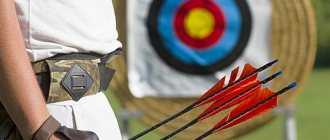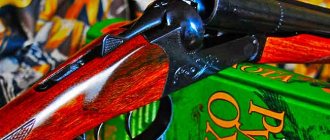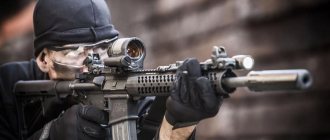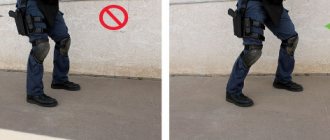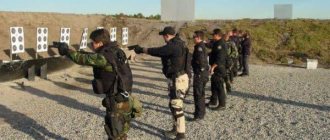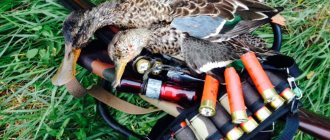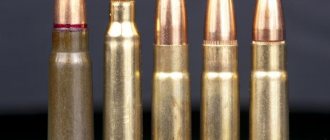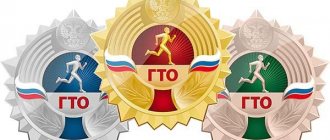War tactics
When shooting correctly at a non-static target, you must take a lead, set the sighting device slightly ahead of the target, or make an adjustment. Having set the required lead, we maintain it until the shot occurs. The weapon should follow the target very smoothly, without jerking or jerking. For example, the distance to the target is about 350 meters. The target is tall, moves in dashes to the right side, and in the half second that the bullet flies to the target, it moves 2 meters. We make a correction on the PSO-1 sight by six divisions. The target will not move outside the main triangle, but inside.
How does this happen in practice? So as not to miss a target that is moving. It is necessary to move not individual parts, but the entire weapon-shooter system. If you move the rifle with your hands, you won't do any good. When you move your stomach or shoulders, the rifle will start to jerk. Good snipers use the "boot movement" method. Once you are in the correct prone shooting position, point the weapon at the target, move the toe of your left foot away from you and the toe of your right foot toward you. The legs should be pressed very tightly. The weapon will move smoothly horizontally, from left to right. This movement is more sufficient to fire a shot. A good sniper takes 2-3 seconds to aim and shoot. If aiming is delayed, it only causes harm, because the sight begins to twitch.
If the target is tracked for a very long time, this leads to the shot being divided into several parts. Which leads to a change of attention from the target to the trigger. Remember, the shooter most often enjoys the keen attention of the audience, and if it has passed through the target, it will be difficult to hit. Experienced snipers shoot quite quickly at a target that is running. Almost immediately catching up with the target with the sight and driving it to the required number of marks. With this method of shooting, due to the inertia that arises, it is not possible to completely slow down the rifle.
It is very difficult to shoot at a target that is in constant motion. One of the most common mistakes is stopping the weapon immediately after firing. Often the shooter stops even when he feels that the trigger has already begun to move. If a shot is fired from a stationary rifle, the target will move to the side by more than a meter.
If a conventional sight is used when shooting at a moving target at a distance of over 300 meters, 1 – Move the target 2 – Move the weapon 3 – Control the trajectory 4 – Maintain the horizon line. 5- Continue fine-tuning the weapon after the shot The ability to correctly shoot at a running target is very important for a sniper during combat operations, where there are no static targets in principle. If the shot is fired from a standing position, aiming is performed by turning the body at the waist. In this case, the upper body is completely secured, the elbow rests on the side of the body. The left hand in which the weapon is held is in a vertical position.
In addition, accurate shooting at non-static targets is a good sport. At the beginning of the 70s of the last century, all shooting ranges were equipped with special installations for shooting at constantly moving targets. The targets moved at different speeds and different distances. Even in DOSAAF, such shooting was practiced every day. Nowadays, the ability to shoot correctly at non-static targets is considered a sign of the highest class.
It's boring to shoot at stationary targets!
Someone once wrote me a comment on my post that shooting at stationary targets is boring, and now I want to tell you why this is not so and what the words “shooting at targets” really mean. Attention: there are a lot of letters, but I think it’s interesting and important.
First of all, we don't just shoot at stationary targets. Of course, they are the majority, but that’s not what this topic is about. Today I will start with the first steps - training, and in the next post I will talk about how interesting it is at competitions.
Practical shooting is a sport in which a person can become a professional not in a narrow specialization, but develop from all sides. Unlike other shooting sports, the winner here is not the most accurate and not the fastest shooter, but the one who has a whole set of different skills and who is better developed in their complex.
In general, I believe that practicing practical shooting brings you closer to the ideal person.
What skills are needed to succeed? Of course, accuracy and speed, and the speed of movement is no less important than the speed of fire. And also coordination, stretching, stabilization, good muscular frame, breathing, spatial thinking, stress resistance, concentration, good memory, attention, ingenuity, quick reaction. It seems like I haven’t forgotten anything 
STAGES OF TRAINING
Learning to shoot is not that difficult. Pulling the trigger quickly is also not a problem. Pressing quickly and getting there is already more difficult. But you can learn this quite quickly - you just need to shoot, that’s all.
Practical shooting is a more complex process. Imagine that you are a baby. You don’t know how to walk, talk, you don’t even know how to hold your head up yet. So learning to shoot is like learning to hold your head. Then you begin to crawl - that is, you learn not just to shoot, but to make transfers from distant targets to near ones and from near to distant ones. Then learn to sit - shoot after moving (shot, move, stabilize, shoot). But in order to start walking, you still need to do a lot, a lot of work! You need to learn how to quickly load and reload a weapon, shoot from awkward positions, shoot from different levels (top, bottom, middle), eliminate delays on the weapon (even if your weapon is perfect, you are not immune from a defective cartridge.
On top of that, to learn to walk, you need muscles! Namely: a strong back (especially if you shoot a 12-gauge shotgun with such heavy recoil), strong arms; It is especially important for pistol users to have strong forearms, since the pistol must be held quite tightly in the hands to compensate for recoil. You need strong legs to run fast and shoot smoothly in different levels. If you want to avoid problems with very low levels (we call them low ports), then you need to stretch. “If you run out of breath” during long exercises, it means your breathing is weak, you need to take up running, basketball, football, cycling, or just jumping rope.
This is a small part of my unarmed training.
And that is not all! The next step is balance, this is necessary for shooting from awkward positions. There are exercises in which you have to stand with a weapon in a position in which you would not be able to stand without a weapon. Usually during exercises there is an alternative option for hitting such a target, without “acrobatics”, but then you can waste time. Therefore, coordination is very important.
Then you learn to shoot on the move like a pro, and then you're ready to take the first step!
SAFETY
The second big and important point after “physics”: during all training, you accustom your brain to safety precautions. For her slightest violation - disqualification from the competition! In any weather, in any conditions, in any situations, you must remember that the barrel must be pointed towards the targets, that if you are not going to shoot, then your finger must be removed from the trigger, the barrel must in no case be pointed at parts of the body, and Before you shoot, you need to make sure that there is no one in front of or behind the target.
It is forbidden to swing the barrel in all directions; it must be within the safety angle.
Now imagine that it’s winter outside and you slip while exercising. Your actions? Try to fall as softly as possible? But no. The practical shooter, during a fall, removes his finger from the trigger, points the weapon towards the targets, ensures that no part of the body is carried through the barrel during the fall, and controls the safety angle. And if he has fallen so far that he sees the target and is sure that there is no one in front or behind it, then he continues shooting. Laughter and laughter, but we had something like this: Roman Khalitov, safely (!) falling on his butt and continuing to ride it, shot the remaining targets!
NERVES, GAME PLAN, ABSTRACT THINKING
Let's return to our baby. Now you can take a few steps, shoot confidently and go to your first competition. There are the first obstacles on your way that you need to step over, but you only stumble over them, and in competitions everything goes awry. This usually happens when your nerves are acting up: you think that people are looking at you, you are afraid of getting disqualified - in general, your brain goes to the dark side of the force! And if you don’t have competitive experience or at least experience in public speaking, then you’ll have to work specifically with your nerves. Personally, it was hard for me, I showed poor results in many competitions due to nerves - I shot well, but my nerves ruined everything.
A little about how to train your head 
Further, in competitions, a correctly constructed game plan is 50% of success. There are shooters - geniuses of game plans who "tear" everyone with their tactics. To be able to do this, you need to develop your brain. Most often, the exercise is structured in such a way that it can be completed in one or two ways: for example, start not on the right, but on the left. But there are also those where you can come up with five or seven ways! Not every shooter is able to come up with good tactics for completing an exercise, and there is nothing shameful in that, but this skill turns good shooters into great ones.
And that is not all. The ability to build tactics is more of a bonus rather than a necessity for a practical shooter. But abstract thinking is something you can’t do without. Before the exercise, you are given only three minutes to prepare. The shooters go through the exercise without weapons, as a whole group, getting in each other’s way. During this time, you need to have time to find all the targets and come up with tactics (or, in extreme cases, spy). If the exercise is difficult, then three minutes is not enough, and you have to use your imagination and memory. While other shooters are going through the drill, you need to remember every move, every target, every action - open the door, change magazines, crouch. You need to go through the exercise several times in your head, otherwise in a stressful situation you can forget basic things. For example, I once missed a huge popper standing right in front of me! When I discharged and they announced to me that I had a miss and a penalty for not firing at the target, I was very surprised, I began to look around and could not find this ill-fated target. And then the judge showed that right in front of me, seven meters away, was a huge popper!
And one moment. So you’ve prepared for the exercise, you’ve gone over in your head several dozen times what you’ll do after the timer signal, you’re perfectly prepared – but then suddenly everything doesn’t go according to plan. For example, you made several mistakes, and because of this you have to change stores earlier. This can be critical and you may need to come up with a new game plan - in a split second!
At competitions, you can get nervous and forget your shooting position, forget where the targets are located, forget your game plan, forget to load your magazines and come out with half empty ones. That’s why it’s so important to learn how to deal with nerves and develop your brain.
SUMMARY 
So, in order to learn to “walk” - that is, shoot at targets - you need to: learn to follow safety precautions (to the point of automaticity!), learn to shoot (from all possible positions, levels, on the move, on the run, etc.), bring tone your muscles, learn to keep balance (not just stand, but shoot in an awkward position!), have a flexible body, develop your brain (fantasy, abstract thinking, logic), learn to control your emotions (you have a weapon in your hands - you are not allowed to freak out, even if you are a girl, a grandmother or a child! I, being a very emotional person, had a very hard time getting this flaw out of myself), learn to cope with stress.
Moral preparation in full swing
And this is just the beginning of the journey! After all, after a child has learned to walk, he will have to master running, jumping, and so on.
Oh, it seems like it turned out to be a lot. But now, I think it’s obvious that shooting at targets is not boring - with such a volume of everything, you won’t get bored. I would like to wish the most important thing to novice shooters: don’t give up! I have yet to see a child who, having tried to get up and falling, decided: “Oh, well, since it’s such bullshit, then it’s not my thing.”
But now, I think it’s obvious that shooting at targets is not boring - with such a volume of everything, you won’t get bored. I would like to wish the most important thing to novice shooters: don’t give up! I have yet to see a child who, having tried to get up and falling, decided: “Oh, well, since it’s such bullshit, then it’s not my thing.”
